PRESTO PLANS
Sent straight to your inbox
CLICK HERE TO ACCESS
Sign up to receive 10 ready-to-use ELA resources your students will love!
10 FREE ELA RESOURCES
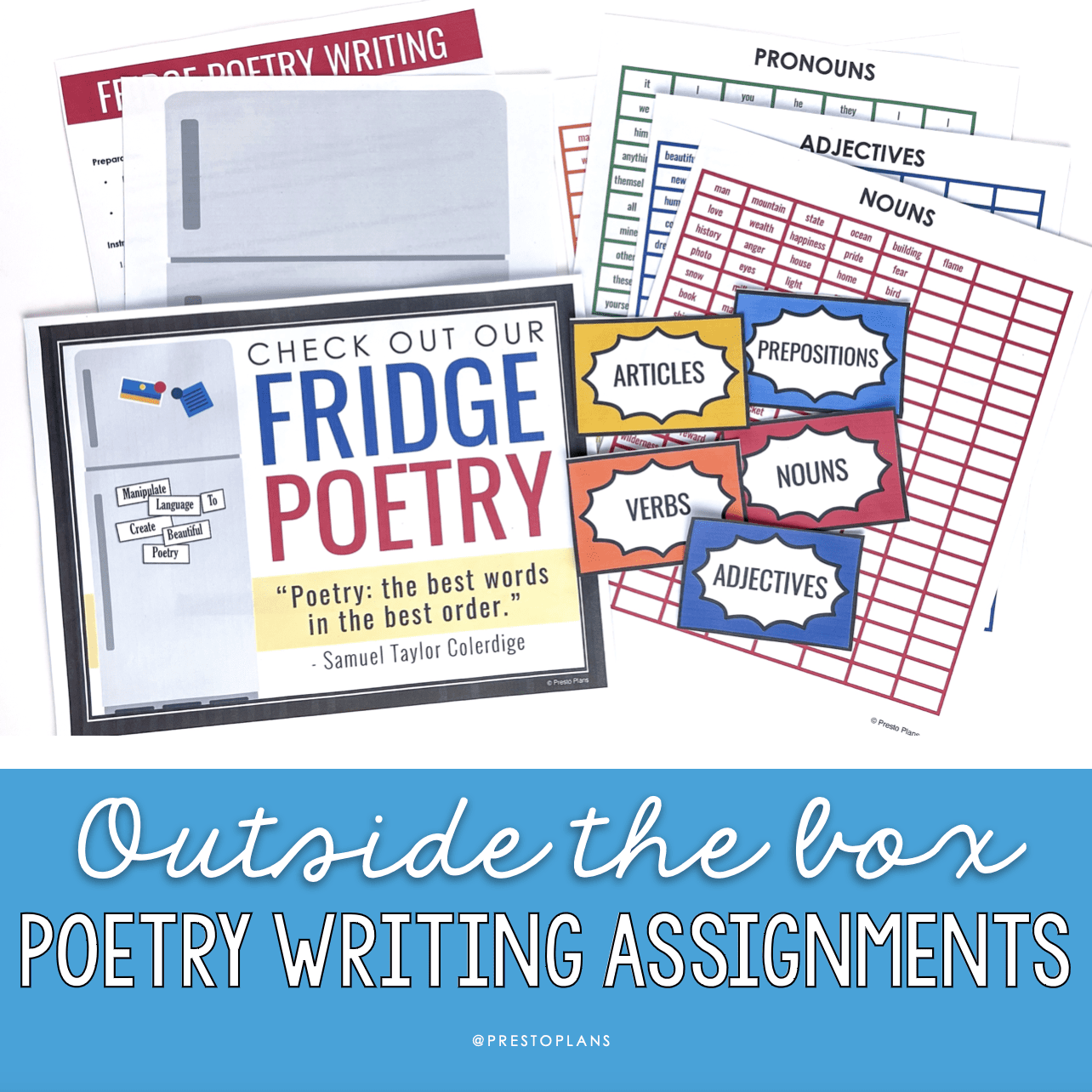
Outside-the-Box Poetry Writing Assignments for Middle School ELA
Happy Poetry Month! Do you find your students struggle with poetry writing assignments? You’re not alone! I notice that many middle and high school students find it challenging to tap into their creative side, especially when it comes to poetry composition.
One trick I find useful is to take an outside-the-box approach to poetry writing activities. When students understand the framework of each type of poem and are given a bit of freedom to play with words, rhymes, and figurative language, you might be surprised at what they can come up with! Here are five of my favorite poetry writing assignments to get students’ creative juices flowing!
1. Texting Poetry
I’ve never met a middle or high school student who isn’t hooked on texting! In this high-interest activity, students must write a poem that incorporates the short-hand conventions of texting. Think abbreviations, acronyms, digits, emojis and more! I find this task works especially well as an introductory activity to a poetry writing unit, as it appeals to even the most reluctant writers!
To begin, show students some strategies to utilize texting convetions. These could include:
- Omitting letters, especially vowels, to shorten words (“text” becomes “txt)
- Abbreviations (“you only live once” becomes “YOLO”)
- Replacing words with numerical digits (“too” becomes “2”)
- Inserting emojis to express tone and emotion
From here, students can use a provided graphic organizer to brainstorm, draft, and edit their texting poems, before creating their good copy! To wrap up, students can neatly format their finished poem into a template that is shaped like a phone – perfect for displaying on a classroom bulletin board!
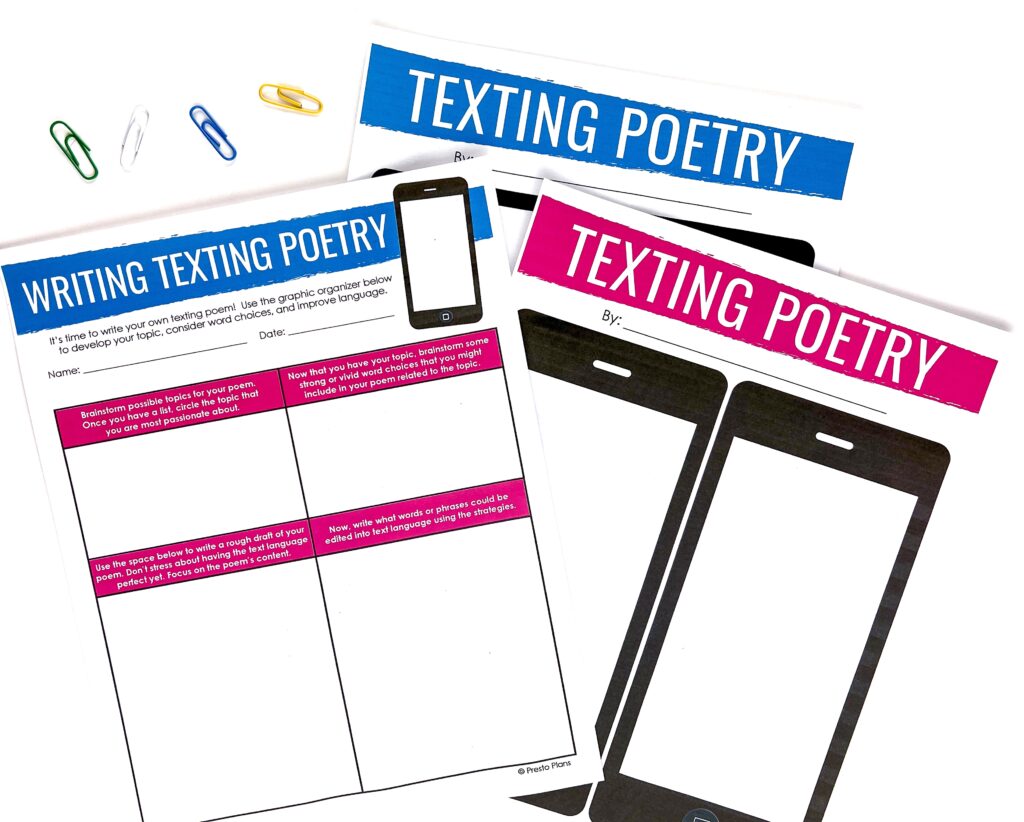
2. Slam poetry
What better way to wrap up a poetry unit than by hosting a classroom poetry slam? For this activity, students prepare to perform spoken word poetry for an audience of their peers! Most students aren’t familiar with the idea of a poetry slam. I like to start by explaining it is a competitive event where poets perform their work and are judged by the members of the audience. At a poetry slam, scores are given based on the content of the poem, as well as the poet’s performance!
First, I like to share some brief details about the origin of poetry slams, and offer some tips for writing spoken-word poems. The most impactful slam poetry performances show the poet’s emotional connection to the topic. It can be useful to give students an opportunity to brainstorm (or even free write!) to help them work through their initial ideas.
From here, I like to provide students with some examples of professional slam poetry performances. Once they have plenty of inspiration, a graphic organizer can help students begin the writing process.
For the slam itself, I like to outline some clear ground rules. Five students (chosen at random) will provide scores out of ten for each performance. For fairness, I like to “throw away” the highest and lowest score, leaving each poet with a score out of 30. To sweeten the deal, I like to offer a grand prize to the poet with the highest score (and participation prizes for all students who are brave enough to perform)!
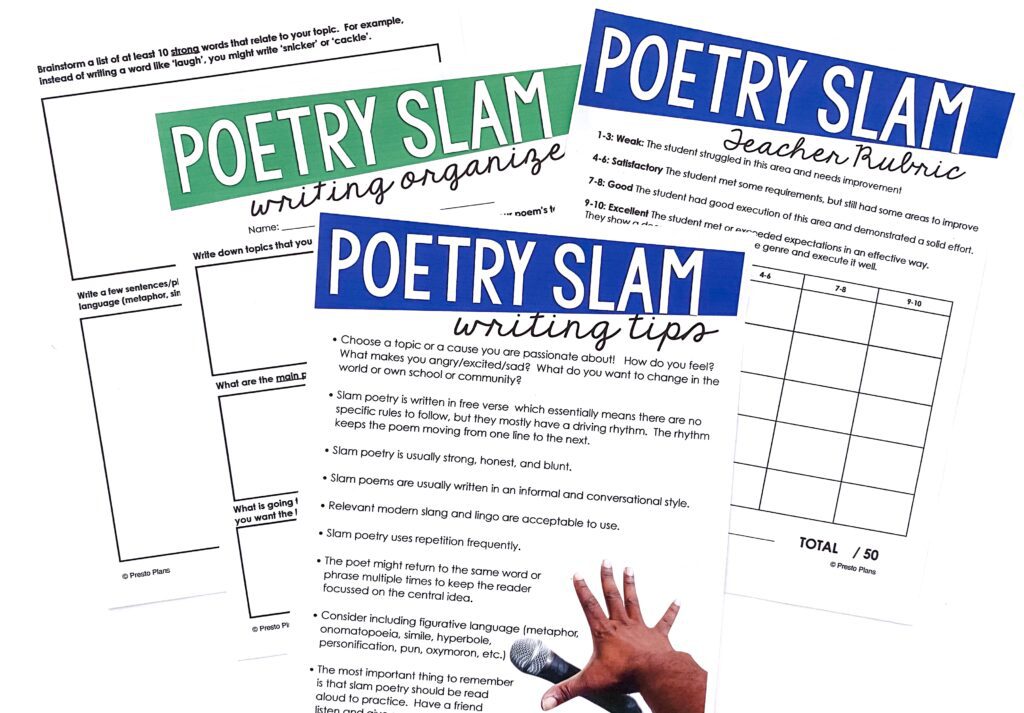
3. Poetry Portfolios
Sometimes, the simplest poetry writing assignments are the most effective! If you’re introducing several different poetry styles to your middle school ELA students, why not have them try to compose a poem in each style? I find that sometimes, providing a clear framework for each poetry type can inspire students to produce very creative results!
In the Poetry Portfolio task, students learn the “rules” of composing eight different styles of poetry, including:
- Bio poems
- Acrostic poems
- “I am” poems
- Haiku
- Concrete poems
- Antonym diamante poems
- Limerick
- Quatrain
Once they understand the basic structure of each poetry type, they can use the provided reference materials to compose a draft of each kind of poem before editing their work. To assess this poetry writing assignment, you could collect a full portfolio of poetry for each student, or you could have them pick and choose examples of their best work to mark and display!
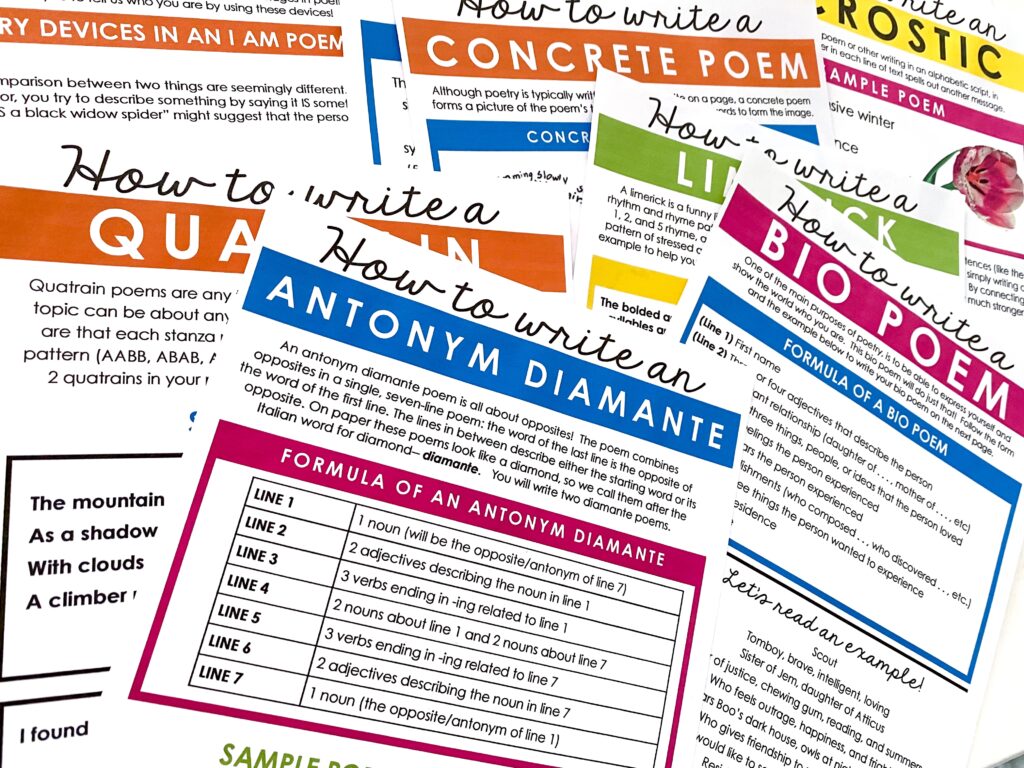
4. Fridge poetry
For an outside-the-box way to encourage students to engage with poetry, why not try a writing activity inspired by “refrigerator poetry?” These are the small, magnetic words that can be arranged into various poems you might have seen on refrigerators
In this poetry writing task, students use words from various parts of speech to create their own poems (no magnets required). Refrigerator poetry can teach vocabulary, independent thinking, imaginative personal expression, parts of speech, word choice, sensory detail, and phrasing!
This task requires a little bit of prep work, but the result is worth it! I like to separate and sort words into various categories related to parts of speech. The day before the lesson, organize and label baskets or jars with various parts of speech, and fill each jar with small cards that contain different types of words. From here, students can select a variety of different word types, spread them out, and arrange (and rearrange!) them to create poems!
Refrigerator poems can be shown off in your classroom, or posted on a hallway bulletin board for a creative, student-centred, and low-prep display!
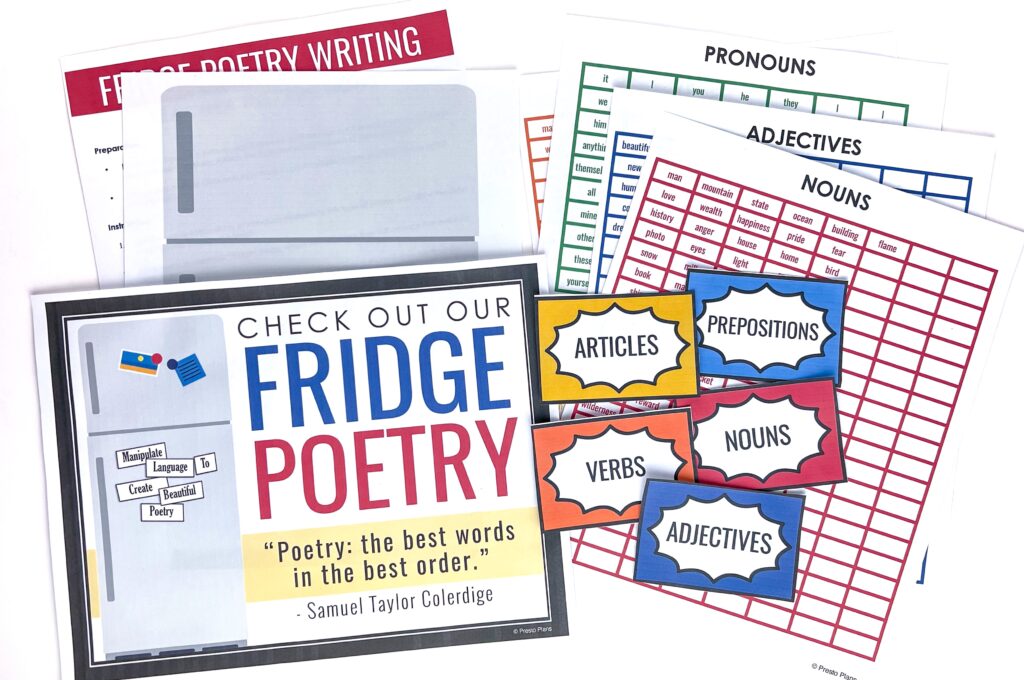
5. Acrostic Snowball Poetry
If you have a class that loves to get up and moving, Acrostic Snowball Poetry is the writing activity for you! This task is one of my favorite poetry writing assignments! It requires students to work collaboratively as they compose acrostic poems, and I find it engages even the most reluctant writers!
To start, distribute organizational templates for various acrostic poems to your class. Once everyone has a unique poetry prompt, I explain that an acrostic poem is a type of poetry where the first letters of each line combine to spell out a word, name, or phrase when read vertically.
From here, it’s time for the fun to begin! I like to set a timer (two minutes works for me – you may need to adjust slightly for your group!). Students need to put their name on their page and write the first line of a poem. This line should correspond with the first letter provided in the template. Once the time is up, they crumple their paper into a “snowball.” Next, they throw it into the centre of the room, grab another page, and continue writing on the next line! At the end of the activity, all the “snowballs” should be returned to their original writer. Finally, they can then create a good copy to share with the class!
A tip for Acrostic Snowball Poetry: Encourage students to write with a pen, as pencils can smudge during all the crumpling/smoothing out!
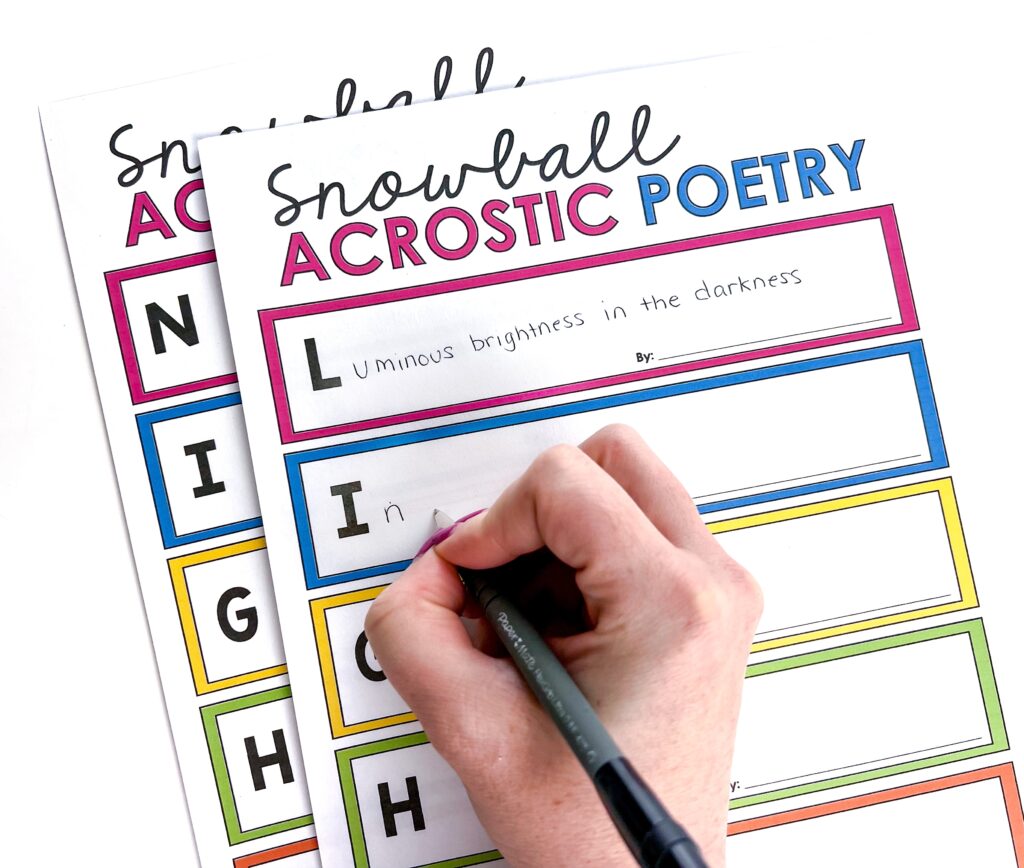
There you go! I hope these activities give you some fresh ideas for your poetry unit! You can find all five of these outside-the-box activities in my Poetry Writing Bundle!

Looking for more ways to have fun with poetry in your classroom? Check out my post on Using Music to Teach Poetry in Middle School ELA!
Search the blog for what you are teaching
GIVEAWAYS
sent straight to your inbox!
share this post